- Thursday, April 25, 2024
A to Z of an action entertainer that redefined the Bollywood hero and launched a new era
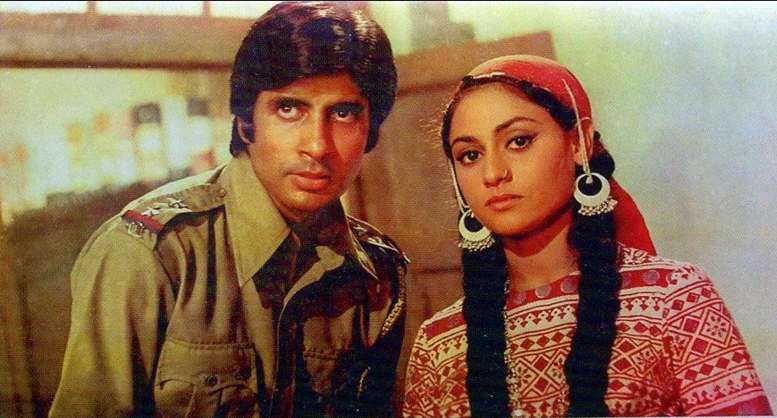
By: Asjad Nazir and Dharmesh Patel
To say that Zanjeer is one of the most important Hindi films in history is a major understatement.
Apart from introducing a new style of filmmaking, and giving rise to the angry young man, the crime drama started Amitabh Bachchan’s remarkable rise towards becoming the greatest Indian cinema hero in history.
The movie masterpiece, released on May 11, 1973, marks 50 years this week. Eastern Eye decided to celebrate with an all you need to know A to Z of an action entertainer that redefined the Bollywood hero and launched a new era.
A is for Angry: The persona of the ‘angry young man’ was created with Zanjeer and the character played by Bachchan. It connected with disaffected youth, who were disillusioned during a time of unemployment, corruption, and increased living costs. That persona of the angry man fighting back would reappear in his movies throughout the seventies and became a part of popular culture. Although the screenplay is credited to writing duo Salim-Javed (see W), Salim Khan would later say he had conceptualised that angry young man image and storyline before teaming up with Javed Akhtar.
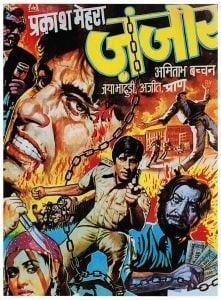 B is for Breakthrough: After struggling to establish himself, Bachchan became an overnight superstar with the release of Zanjeer and packed a generation of leading men into retirement. He became the hottest property in Bollywood after his incendiary turn and changed the Indian cultural landscape. He would earn the first of many Best Actor award nominations for his performance. (Interestingly, Bachchan had thought of quitting if Zanjeer didn’t work).
B is for Breakthrough: After struggling to establish himself, Bachchan became an overnight superstar with the release of Zanjeer and packed a generation of leading men into retirement. He became the hottest property in Bollywood after his incendiary turn and changed the Indian cultural landscape. He would earn the first of many Best Actor award nominations for his performance. (Interestingly, Bachchan had thought of quitting if Zanjeer didn’t work).
C is for Chewing gum: Bachchan chewing gum while fighting villains in Bombay To Goa (1972) inspired writing duo Salim-Javed to cast him in the movie. The actor revealed that important chewing gum connection decades later.
D is for Director: After making a few forgettable films, Prakash Mehra came to prominence as a producer and director with Zanjeer. A movie no frontline star was interested in turned him into a power player in Hindi cinema and started a dream run of movies headlined by Bachchan, including Hera Pheri (1976), Khoon Pasina (1977), Muqaddar Ka Sikandar (1978), Lawaaris (1981), Namak Halaal (1982) and Sharaabi (1984).
E is for End of an era: The stunning success of Zanjeer put an end to the dominant romantic genre in Bollywood and launched an era of action. In the 16 years that followed action would rule in Hindi cinema, and anti-heroes would dominate, largely thanks to Bachchan’s powerful performance.
F is for Filmfare awards: The film was nominated for eight Filmfare Awards and won four, for Best Lyricist (Gulshan Bawra), Best Story & Screenplay (Salim-Javed) and Best Editing. Bachchan got a Best Actor nomination and should have won but was beaten by Rishi Kapoor (Bobby), who revealed decades later he had bought the award. Zanjeer lost out on Best Film to the long forgotten Anuraag (1972).
G is for Goga Kapoor: Bachchan had been given a small role in the theatre play Othello in the 1960s by Goga Kapoor and recommended him for Zanjeer. That big break for Kapoor would kick-start a successful film/TV career that lasted nearly 40 years.
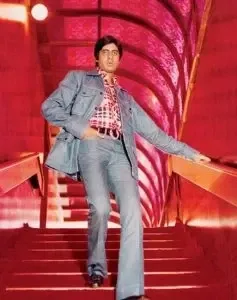 H is for Horse: Writing duo Salim-Javed took inspiration from Italian western Death Rides A Horse (1967) for the story of Zanjeer. Both revolve around a child, who witnesses brutality and takes revenge during adulthood, using what he memorised during the attack. In Zanjeer, there is a horse with a charm bracelet and him having recurring nightmares about a stallion.
H is for Horse: Writing duo Salim-Javed took inspiration from Italian western Death Rides A Horse (1967) for the story of Zanjeer. Both revolve around a child, who witnesses brutality and takes revenge during adulthood, using what he memorised during the attack. In Zanjeer, there is a horse with a charm bracelet and him having recurring nightmares about a stallion.
I is for Inspiration: A lot of very famous names were inspired to pursue acting after seeing Bachchan’s performance in Zanjeer, including Indian superstar Rajinikanth and the award-winning actor Manoj Bajpayee.
J is for Jaya: The first choice for the female lead was Mumtaz, but she opted to get married and leave Hindi cinema. Other famous heroines also refused to star opposite Bachchan, but Jaya Bhaduri believed in his talent and agreed to take the role. Both married weeks after the movie became a sensation.
K is for Kalyanji Anandji: Mehra had used music duo Kalyanji Anandji for his directorial debut Hasina Maan Jayegi (1968) and teamed up with them again for Zanjeer. They would go on to work for most of his subsequent movies, with great success.
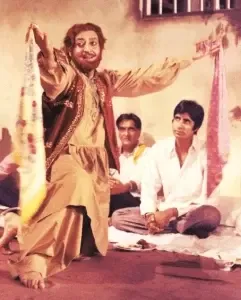 L is Love: Unlike most Hindi movies made up until that point, the rugged hero didn’t have a romantic story angle and didn’t perform any of the songs, which was considered revolutionary at the time.
L is Love: Unlike most Hindi movies made up until that point, the rugged hero didn’t have a romantic story angle and didn’t perform any of the songs, which was considered revolutionary at the time.
M is for Money: The distributors had not believed in Bachchan, so Zanjeer had a slow start at the box office and many thought it would be a costly misfire. But the movie then picked up pace after a week when word of mouth spread and soon became the hottest ticket.
N is for No: A lot of leading men had famously refused the chance to play the path-breaking role, including Dharmendra who had, at one point, held the story rights. Others who refused the role were Dilip Kumar and Dev Anand. Raaj Kumar had initially agreed, but legend has it that he refused to work with Prakash Mehra on the grounds that he could not stand the smell of the latter’s hair oil. All this led to Bachchan being cast and becoming bigger than all those who said no.
O is for Overseas: The film did its biggest business overseas seven years later when it was released in the then Soviet Union and became a runaway success in 1980. It struck a chord with Russian audiences in a big way and was declared a blockbuster.
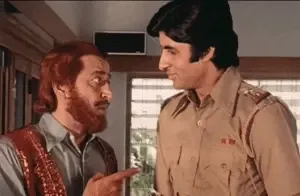
P is for Pran: This was the first time Bachchan and Pran appeared in a movie together. They would subsequently act together many more times. Interestingly, Pran, who was known to play villains, portrayed a positive character. Although Salim-Javed took the credit for discovering Bachchan, Prakash Mehra’s son said in an interview that Pran had recommended him and taken his father to watch Bombay To Goa (1972).
Q is for Question: Whether it is the protagonist being a big fan, shades of Deewaar (1975) with the two brothers on opposite sides of the law or the Kaun Banega Crorepati show he is famous for hosting, there are various Amitabh Bachchan influences throughout the Danny Boyle-directed Oscar-winning movie Slumdog Millionaire (2008). A quiz question central to the story includes, ‘who was the star of the 1973 hit film Zanjeer?’.
R is for Remake: There have been various remakes of Zanjeer in different languages across the years including Nippulanti Manishi (Telugu) and Sirithu Vazha Vendum (Tamil) in 1974, and Naayattu (Malayalam) in 1980. In 2013 a Hindi and Telugu remake were made simultaneously as Zanjeer and Toofan. Salim-Javed were keen on an English remake but that never materialised.
S is for Songs: It was unheard of for Bollywood heroes not to have songs picturised on them, but that is what happened in Zanjeer because Bachchan was playing a tough guy. Something similar happened with his films like Deewaar (1975), Trishul (1978), Kaala Patthar (1979) and Agneepath (1990).
T is for Top tune: The stand-out song in the Kalyanji Anandji composed soundtrack was Yaari Hai Imaan Mera Yaar Meri Zindagi. The terrific track sung by Manna Dey was named by India’s most popular weekly countdown show, Binaca Geetmala as their Bollywood song of the year for 1973. Incidentally, Pran had initially refused to sing or dance in the movie, but he ended up having the best musical moment with this superhit song.
U is for Unforgettable: What makes the movie special is that it’s loaded with magnificent scenes from start to finish, which have become iconic. This includes Sher Khan going to sit down at the police station and an enraged inspector Vijay kicking away the chair. That simple act followed by a fiery dialogue showed this was a grittier type of Hindi movie. That was one of many great moments.
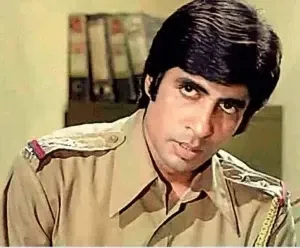 V is for Vijay: Zanjeer was the first time Bachchan played a character named Vijay. That power-packed name, meaning victory, would be used by the actor in some of his most famous movies including Roti Kapada Aur Makaan (1974), Deewaar (1975), Hera Pheri (1976), Trishul (1978), The Great Gambler (1979), Shahenshah (1988), Agneepath (1990) and Aankhen (2002).
V is for Vijay: Zanjeer was the first time Bachchan played a character named Vijay. That power-packed name, meaning victory, would be used by the actor in some of his most famous movies including Roti Kapada Aur Makaan (1974), Deewaar (1975), Hera Pheri (1976), Trishul (1978), The Great Gambler (1979), Shahenshah (1988), Agneepath (1990) and Aankhen (2002).
W is for Writers: Although Prakash Mehra produced and directed Zanjeer, creatively it was the baby of writing duo Salim-Javed. They not only introduced a new kind of writing but were involved in key decisions and like Pran (see P) claim they recommended Bachchan for the lead role. They would win the Story and Screenplay Filmfare Awards, and kickstart an incredible run of superhits, including writing movies in the same genre for Bachchan such as Deewaar.
X is for X Factor: Up until Zanjeer was made, most Bollywood heroes had a kind of sensitivity or a soft emotional core, but all that was dispensed with. That along with the raw style of filmmaking set the action thriller apart. Of course, the other big X Factor was a lead star who set the screen on fire and connected with grassroot audiences in a way no other had before.
Y is for Yaadon Ki Baaraat: Writers Salim-Javed reworked the similar Zanjeer-inspired plot from Death Rides a Horse for Yaadon Ki Baaraat, which was released later in the same year and also became a big success. Ajit played the villain again, wearing one size 8 and another size 9 shoe.
Z is for Zanjeer: A film named Dushman was originally supposed to be titled Zanjeer, but after that didn’t happen, it was given to Prakash Mehra. He used it on a magnificent movie that became all-time classic and is much loved 50 years later. For that, we give it a Big B salute.